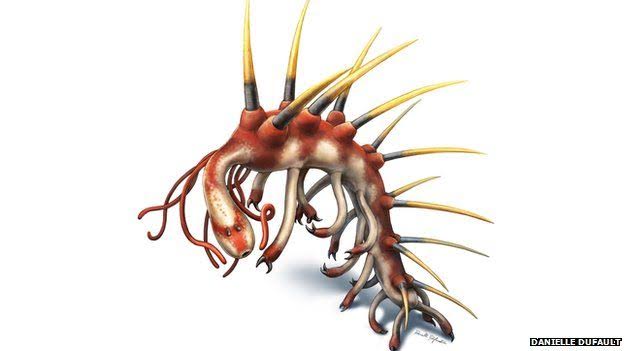Until now, scientists did not know what the head of Hallucigenia looked like
Scientists finally have a complete picture of what one of nature’s most bizarre animals looked like.
The tiny sea creature – Hallucigenia – lived 500 million years ago, but all fossils appeared to be without heads.
New specimens unearthed have revealed the missing part, revealing its strange face for the first time.
Dr Martin Smithsaid: “It looks completely surreal. It is like something from another world.”
The fossils are more than 500 million years old, dating back to the Cambrian Period
The first Hallucigenia fossil was discovered more than 100 years ago, and it baffled scientists.
The creature was tiny – less than 2cm long and thinner than a hair – but very strange.
One side of its thin, tube-like body was covered in pairs of enormous spines, while flimsy, stick-like clawed appendages dangled from its other side.
“When it was first formally described, it was the wrong way up. It was only recently that we found on which side were its feet and which side was its back.
“Even then there has still been a lot of ambiguity as to which end was the head and which end was the tail.”
By delicately chipping away at the rock, scientists found a spoon-shaped head with some surprising features.
The dark blob – seen here to the left – was once thought to be the creature’s head
“When we put it into the electron microscope, we were delighted to see not just a tiny pair of eyes looking back at us, but also beneath them a really cheeky semi-circular smile.
“It was as if the fossil was grinning at us at the secrets it had been hiding,” explained Dr Smith.
Inside the creature’s mouth, the researchers found a ring of teeth and then another set of teeth running from its throat down towards its stomach.
The scientists believed Hallucigenia used its odd mouth arrangement to suck up food, and then move it down to its gut.
The study also helped to clear up another mystery – a strange blob found on the fossils that was once thought to be the creature’s head.
“What our study shows is that it has a different composition from the animal. And rather than representing part of its body, it actually represents decay fluid – the contents of its guts – squeezed out as the animal was buried and fossilised,” said Dr Smith.
Scientists say Hallucigenia is helping them to learn more about the Cambrian Period – a time when life exploded into a rich array of forms – and how it then settled back into the more normal looking creatures we see today.
“Velvet worms also possess a worm-like body with paired non-jointed legs, but they don’t have paired dorsal spines.
“The discoveries will improve our understanding of the early evolution along the evolutionary line leading to today’s velvet worms.
Source: BBC
N.H.Khider

